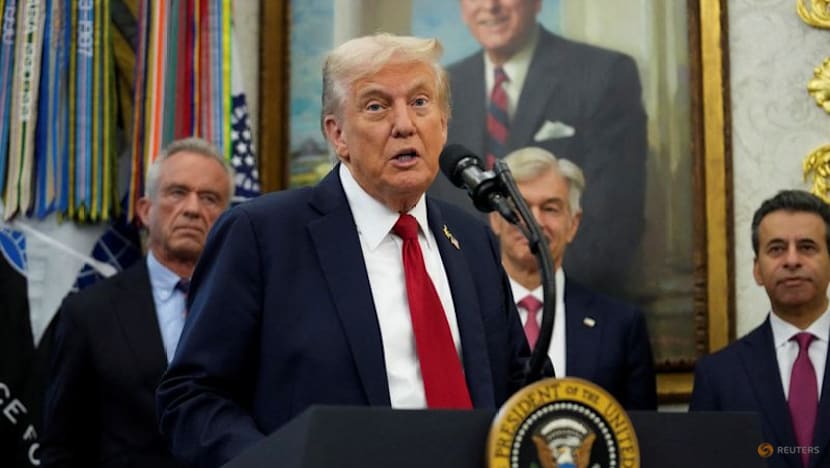Commentary: ‘Treat us like we treat you’ – Trump’s latest sectoral tariffs are a warning Southeast Asia must heed
US President Donald Trump’s latest tariffs on pharmaceuticals and timber show that his tariff spree is far from over. More than economic goals, he is searching for self-sufficiency, says Kevin Chen from the S Rajaratnam School of International Studies.


This audio is generated by an AI tool.
SINGAPORE: Just when governments thought they had successfully negotiated lower tariffs, they are now forced to reckon with a new set.
On Sep 25, United States President Donald Trump announced sweeping new tariffs on specific sectors, including a 100 per cent tariff on patented pharmaceuticals and 25 per cent on all heavy trucks. More came four days later on Monday (Sep 29) – this time on imports of timber, lumber and derivative products such as kitchen cabinets.
Amid warnings of impending semiconductor tariffs, this latest blitz was a one-two hit for the Association of Southeast Asian Nations (ASEAN). Just hours before the Sep 25 announcement, the grouping’s economic ministers met with US Trade Representative Jamieson Greer in Kuala Lumpur to appeal for lower tariffs across the board. He demurred.
On one hand, the US and ASEAN economies are still “in the process of negotiating deals” – but he warned that if talks fall through, then “the tariff solution is the solution”. Washington’s trade envoy also declared that “we have to have the supply chains back in the United States,” highlighting national security as the key concern.
Mr Greer’s comment was specifically referring to semiconductors, but the Trump administration is unlikely to stop there. When announcing the timber tariffs, the White House warned of an overreliance on foreign timber, as a matter of national security.
It is challenging to see how national security might apply to kitchen cabinets and furniture, but the messaging is unmistakable. There is no mutually beneficial solution to be had if the red lines of “national security” and “self-sufficiency” are drawn in the sand.
This is an escalation in Mr Trump’s trade war, and a warning that Southeast Asian governments must heed. The sectoral tariffs point to two uncomfortable developments.
DONALD TRUMP’S WINNING STRATEGY
First, it is evident that Mr Trump believes that his tariffs were successful.
After all, if his main goal was to force countries to the negotiating table, the presence of so many trade delegations in Washington over the past several months ostensibly validates his efforts. At the very least, fears about a global trade war were shown to be unfounded because most of America’s trade partners blinked.
Instead, governments assumed that Mr Trump would accept a deal that addressed at least two of his other goals: balancing the trade deficit, which ran to a record high of US$1.2 trillion in 2024, and reviving US manufacturing with foreign investments.
In Southeast Asia alone, governments placed orders for billions of dollars’ worth of Boeing airplanes, natural gas and other American products, while pledging billions more in investments in American manufacturing.
He also wanted to raise government revenue to make up for a shortfall following a slew of tax cuts. His commerce secretary said in August that the US expects to collect at least US$50 billion a month in tariff revenue.
He clearly plans to continue using these tariffs, whether as a tool of economic coercion or foreign policy, as seen in the Thailand-Cambodia border conflict.
NATIONAL SECURITY AND SELF-SUFFICIENCY
Second, while national security needs have featured in White House statements since Apr 2, they were typically broad and open to interpretation.
As the “Golden Rule” of Liberation Day went, the White House wanted other countries to “treat us like we treat you”. Never mind that the so-called “reciprocal” tariff calculation reflected little reciprocity, when countries with free trade agreements still got slapped with tariffs. It still suggested that mutual accommodation was possible.
With the recent sectoral tariffs, however, the narrative has pivoted towards a more alarming goal of self-sufficiency. Intertwining national security with this autarkic belief creates a zero-sum trading approach, where any sort of import dependency could be seen as a weakness.
The goals of reviving American manufacturing and balancing the trade deficit are still relevant, but with no consideration of how non-American economies could benefit as in a positive-sum approach.
Granted, it is entirely possible that Mr Trump could be convinced to offer exemptions if presented with a tempting offer. However, with billions of dollars already committed in purchasing and investment agreements, it is unclear how much more Southeast Asian governments can offer to Washington.
VARYING IMPACT ACROSS SOUTHEAST ASIA
For now, the impact of the sectoral tariffs will vary across Southeast Asia.
Late on Tuesday, it was reported that the White House had paused its plan for the pharmaceutical tariffs, pointing to ongoing negotiations with pharmaceutical giants such as Pfizer. These companies may earn a few years of reprieve, though countries such as Singapore may still face greater risks in the medium term given its export of patented and branded products.
The immediate concern would be for small furniture manufacturers in countries such as Malaysia and Cambodia, which do not have the resources to relocate production to the US.
More broadly, Southeast Asian governments face an unenviable conundrum: Their main recourse against the higher sectoral tariffs is to continue engaging Washington to try and secure exemptions, but doing so reinforces Washington’s belief that tariffs work and incentivises their continued usage.
The uncomfortable truth is that there is little choice but to continue engaging Washington in the short term. In the medium term, however, governments are creating trade networks that reduce their exposure to US coercion to break this cycle.
For example, Indonesia recently signed free trade agreements with the European Union and Canada, while Vietnam is exploring economic cooperation with the South American MERCOSUR grouping. Singapore also concluded the Future of Investment and Trade (FIT) Partnership with 13 other countries, including Chile and Rwanda.
If Washington truly seeks self-sufficiency, governments could well oblige their wishes in the medium-to-long term and find other markets for their goods. After all, “treat us like we treat you.”
Kevin Chen is an Associate Research Fellow with the US Programme at the S Rajaratnam School of International Studies (RSIS), Nanyang Technological University (NTU), Singapore. He writes a monthly column for CNA, published every first Friday.


















